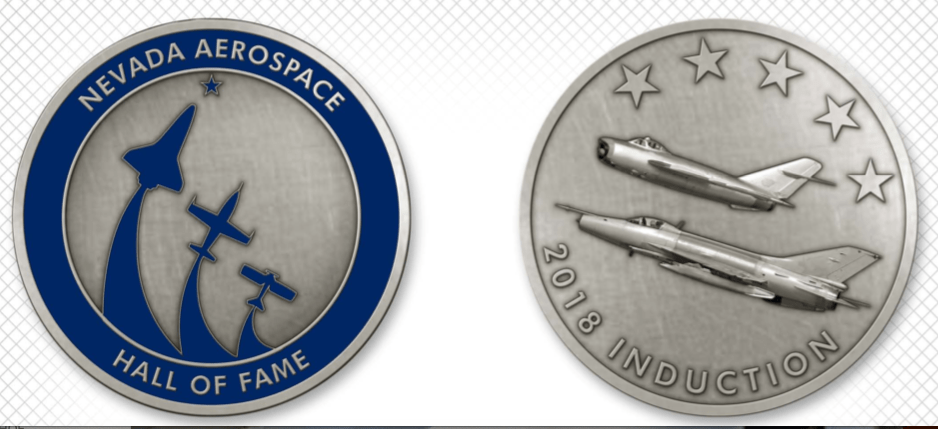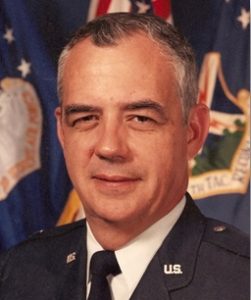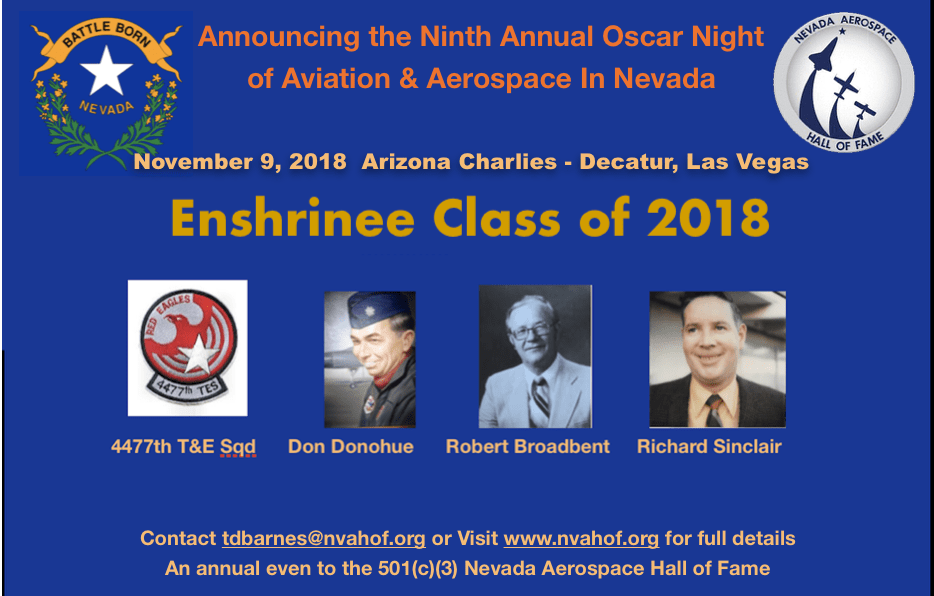
The Nevada Aerospace Hall of Fame, being from the Battle Born state, strongly supports the centuries-long tradition of the challenge coin dating back to the Roman Empire who rewarded soldiers by presenting them with coins to recognize their achievements. The Office of Strategic Services, now the Central Intelligence Agency, first used challenge coins during the Hitler Era by personnel deployed in Nazi-held France. The coins were merely a local coin used as a “bona fides” during a personal meeting to help verify a person’s identity. There would be specific aspects such as the type of coin, date of the coin, etc. that were examined by each party. This helped prevent infiltration into the meeting by a spy who would have to have advance knowledge of the meeting time and place as well as what coin was to be presented, amongst other signals, as bona fides. Quoted shipping rates apply to sales within the USA only. NVAHOF offers challenge coins identifying those units or organizations earning enshrinement into the Nevada Aerospace Hall of Fame so that you can acknowledge further them should you be challenged with a loudly announced “Coin Check,� hoping to nail you for a round of drinks for those producing their coin.
The 2018 NVAHOF Challenge Coin features the 4477th Test and Evaluation Squadron (4477 TES) Red Eagles, US Air Force Colonel Gaillard R. Peck, Jr., and CMSGT Richard F. Sinclair, USAF (Ret) enshrined into the Nevada Aerospace Hall of Fame and is available for purchase in the NVAHOF Online Store. Quoted shipping rates apply to sales within the USA only.
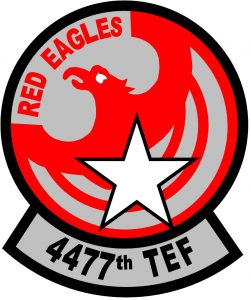
4477th Test and Evaluation Squadron (4477 TES) Red Eagles
The United States 4477th Test and Evaluation Squadron (4477 TES) under the claimant of the Tactical Air Command was a product of Project Constant Peg, a unit created to expose the tactical air forces to the flight characteristics of fighter aircraft used by the Soviet Union during the Cold War.
Secretly operating from the Tonopah Test Range, in Nevada the squadron known as the Red Eagles operated Soviet MiG-17s, MiG-21s and MiG-23s between 1977 and 1988 to train the US Air Force, Navy and Marine Corps pilots and weapon systems officers in air combat tactics against these foreign aircraft. The Red Eagles revitalized the art of dogfighting, bringing fundamental changes in US air combat tactics that played a significant part in the Air Force’s Red Flag program and the US Navy’s Strike Fighter Tactics Instructor program (SFTI), more popularly known as TOPGUN.
For the 4477th TES at Tonopah being instrumental in the re-development of dissimilar air combat training (DACT) methods developed after the end of the Vietnam War, the Red Eagles earned their place in the Nevada Aerospace Hall of Fame class of 2018.
Gaillard R. Peck, Jr.
On April 1, 1977, US Air Force Colonel Gaillard R. Peck, Jr., launched CONSTANT PEG to revitalized the art of dogfighting.
The unit, which became the 4477th Test and Evaluation Squadron “Red Eagles” flew MiG-17, MiG-21 and MiG-23 aircraft, restored to flying status and expertly maintained by technicians every bit as skilled as the pilots. Colonel Peck put the program together, from concept to airfield construction and served as the first commander of the “Red Eagles” at the Tonopah Test Range.
This incredible effort using covertly acquired Soviet-built aircraft prepared American fighter aircrews for aerial combat by using carefully selected US fighter pilots, specially trained in Soviet tactics, to fly these aircraft from the remote Tonopah Test Range airfield in central Nevada. The CONSTANT PEG program provided training that allowed US aircrews to be better prepared to win air combat engagements. Aircrews engaged in mock air combat against a unit that looked like the enemy and flew like the enemy.
For his work on a once highly-classified Air Force program code-named CONSTANT PEG, US Air Force Col Gaillard R. Peck, Jr., earned his place in the Nevada Aerospace Hall of Fame.
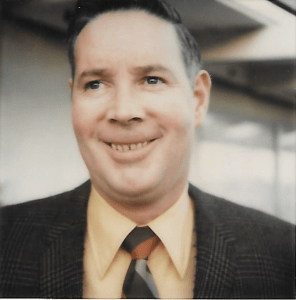
Richard F. Sinclair
In 1967, Richard F. Sinclair served in the United States Air Force at Nellis AFB, Nevada following a tour of duty in Vietnam. While an A-4 aircraft flight chief with the 4538th FWS at Nellis AFB, the Air Force detached him to the Foreign Technology Div. AFSC, Wright Patterson AFB, Ohio in 1968. There, he participated in various exploitation projects in Nevada where he performed technical evaluations of acquired Soviet MiGs that resulted in the Air Force’s Red Flag program and the US Navy’s Strike Fighter Tactics Instructor program (SFTI) known as TOPGUN that reversed the ratio of US military planes lost in the Vietnam War and all wars since.
Now a Senior Master Sergeant, Sinclair continued to work on the classified exploitation program which eventually on 1 December 1977 became the 6513 Flight Test Squadron assigned to the Air Force Flight Test Center at Edwards AFB Ca. Promoted to Chief Master Sergeant, Sinclair continued to serve as the chief of maintenance in the 6513th Flight Test Squadron operating in a classified area in Nevada. For national security reasons, these activities and their venue remain classified. Retiring from the Air Force in 1979 after 28.5 years of military service, he immediately joined The Lockheed Aircraft Company Skunkworks as a lead mechanic for the then-classified development of the F-117 Stealth Fighter. His experience on previous classified programs significantly aided in the fastest development process in the post-WWII era of the F-117 to a fully operational aircraft in two years from its first flight.
CMSGT Richard F. Sinclair, USAF (Ret), for his classified contributions to military aviation in Nevada, has earned his place in the Nevada Aerospace Hall of Fame class of 2018.
Support NVAHOF by purchasing this challenge coin $15.00

NVAHOF membership is open to any individual or organization, public or private, interested in preserving the history of aerospace in Nevada.
NVAHOF is a non-profit organization under Section 501 (c) (3) of the Internal Revenue Code of 1954 and received tax exempt status from the U.S. Internal Revenue Service.
[Membership Levels]
Individual Membership Levels:Lifetime Adult: $500.00 Annual Family: $75.00 (No limit on the number of persons as long as in the same household) Annual Adult: $50.00 Annual Student, Military, Senior (62+): $25.00 |
Corporate Membership Levels:Corporate Champions: $5,000.00 Corporate Patrons: $2,500.00 Corporate Supporters: $1,000.00 Corporate Friends: $500.00 Business: $250.00 |

SUPPORT NVAHOF WITH A DONATION
Contact TD Barnes
The Nevada Aerospace Hall of Fame
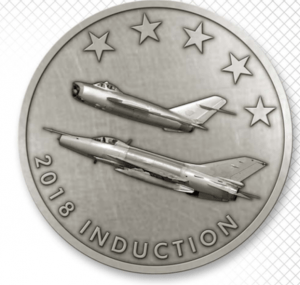
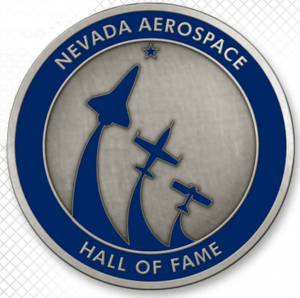
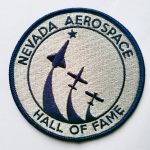
The 2018 Nevada Aerospace Hall of Fame theme and coin commemorates the 50th Anniversary of the first Soviet MiG flight at Area 51 in Nevada
Contact:
Thornton “TD” Barnes
Executive Director – NVAHOF
(702) 481-0568
tdbarnes@nvahof.com
Connie May –
Communications Director – NVAHOF
(775) 530-2297
cpardew@att.net
For Immediate Release
Las Vegas, Nev.
More than 200 people joined in honoring the 9th annual Nevada Aerospace Hall of Fame Enshrinees -Class of 2018 at a gala, red carpet celebration kicking off Veterans Day weekend on November 9 with NVAHOF’s annual “Oscars of Aviation” in Nevada.
Representatives from the 1129th Special Activities Squadron (Roadrunners Internationale) aviation executives and aviation enthusiasts joined with our private sponsors as well as the corporate McCarran International Airport, Lockheed, Bomber Patches, FighterJets Inc., and Dallas Airmotive.
We are honored to enshrine three individuals and one group who have contributed significantly to aviation and aerospace to the Silver State and our country. They are now part of the 47 enshrined since the NVAHOF inception in 2010.
The United States 4477th Test and Evaluation Squadron (4477 TES), The Red Eagles under the claimant of the Tactical Air Command, was a product of Project Constant Peg, a unit created to expose the tactical air forces to the flight characteristics of fighter aircraft used by the Soviet Union during the Cold War.
Secretly operating from the Tonopah Test Range, in Nevada the squadron operated Soviet MiG-17s, MiG-21s and MiG-23s between 1977 and 1988 to train the US Air Force, Navy and Marine Corps pilots and weapon systems officers in air combat tactics against these foreign aircraft. The Red Eagles revitalized the art of dogfighting, bringing fundamental changes in US air combat tactics that played a significant part in the Air Force’s Red Flag program and the US Navy’s Strike Fighter Tactics Instructor program (SFTI), more popularly known as TOPGUN.
Richard F. Sinclair served in the United States Air Force at Nellis AFB, Nevada following a tour of duty in Vietnam. While an A-4 aircraft flight chief with the 4538th FWS at Nellis AFB, the Air Force detached him to the Foreign Technology Div. AFSC, Wright Patterson AFB, Ohio in 1968. There, he participated in various exploitation projects in Nevada where he performed technical evaluations of acquired Soviet MiGs that resulted in the Air Force’s Red Flag program and the US Navy’s Strike Fighter Tactics Instructor program (SFTI) known as TOPGUN that reversed the ratio of US military planes lost in the Vietnam War and all wars since.
As a Senior Master Sergeant, Sinclair continued to work on the classified exploitation program which eventually on 1 December 1977 became the 6513 Flight Test Squadron assigned to the Air Force Flight Test Center at Edwards AFB Ca. Promoted to Chief Master Sergeant, Sinclair continued to serve as the chief of maintenance in the 6513th Flight Test Squadron operating in a classified area in Nevada.
For national security reasons, these activities and their venue remain classified. Retiring from the Air Force in 1979 after 28.5 years of military service, he immediately joined The Lockheed Aircraft Company Skunkworks as a lead mechanic for the then-classified development of the F-117 Stealth Fighter. His experience on previous classified programs significantly aided in the fastest development process in the post-WWII era of the F-117 to a fully operational aircraft in two years from its first flight.
During 1962 to 1965, Donald J. Donohue, as a US Air Force pilot and an aircraft maintenance officer, served with the CIA Project OXCART at Area 51. Retiring from the US Air Force in 1973, Donohue formed Las Vegas Air Lines as the CEO and sole owner, flying Grand Canyon air tour operations until 1998.
Donohue revolutionized Grand Canyon air tour operations by being the first Grand Canyon tour operator to have a multi-language capability, an air-conditioned fleet, instrument capable fleet with all airline transport rated pilots, and to achieve the commuter standards to meet the regulation change in 1979. With international marketing sales offices in 14 countries, Donohue’s company employed up to 64 personnel and operated as many as 31 aircraft, flying as many as 136 flights in one day. He contributed significantly to the national security of the United States while working in obscurity at Area 51 for the CIA.
Robert N. “Bob” Broadbent, a pharmacy owner in Boulder City, Nevada from 1950 to 1975, was a public servant and politician with a storied career that spanned near half a century used his skillful visionary??and negotiator skills and his highest integrity to change the face of Southern Nevada politics. As a member of the Clark County Liquor and Licensing Board in the mid-1970s, Broadbent spoke out against the organized crime regime at the Stardust, launching what would become the most significant purge of the mob from the casino industry in Las Vegas history.
In 1987, Broadbent accepted the post of running the McCarran Airport in Las Vegas, overseeing a budget that exceeded $1 billion a year for what was then the nation’s 21st busiest airport. He managed more than $1 billion in improvements at the airport, including terminal expansion, a new parking garage, a new runway, an international charter terminal and the connector road to Interstate 15. As director of aviation, he rebuilt the North Las Vegas Air Terminal, bought the old Henderson-Sky Harbor airport and refurbished the airstrip in Jean. Broadbent retired from public service in May 1997 with the McCarran International Airport the nation’s ninth busiest airport.
NVAHOF is a non-profit organization under Section 501 (c) (3) of the Internal Revenue Code of 1954 and received tax-exempt status from the U.S. Internal Revenue Service.
Join our past donors in our making it possible to continue our mission of educating the public regarding the history of aviation in Nevada, the contribution of Nevada citizens to the development of global aviation and to preserve the legacy of those men and women who pioneered and advanced our nations aerospace programs within the State of Nevada.
Please visit us at www.nvahof.org
Facebook Nevada Aerospace Hall of Fame
####
Ten pages of photos taken by Dave Budd and Joe Kates
no images were found
